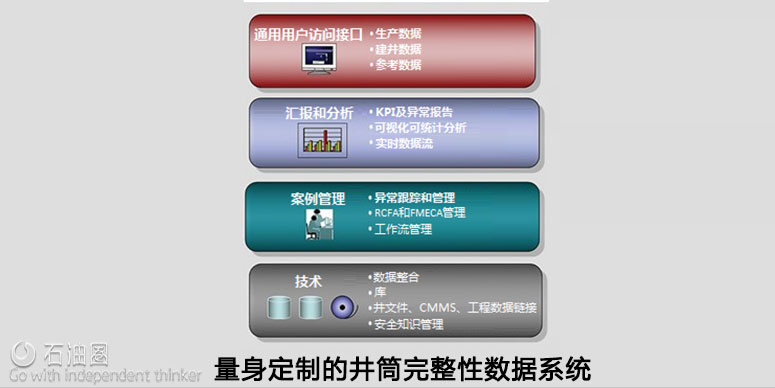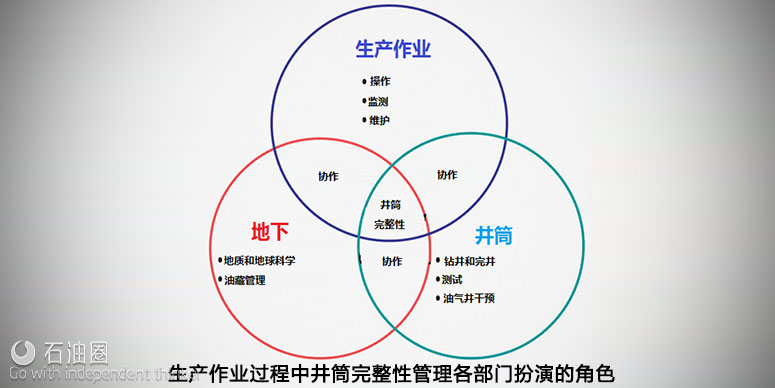Proactively managing WI risk. Many operators are pursuing a common goal with respect to WI—to develop and sustain a risk management process that effectively assesses and reports the relative WI risk across the companies’ entire well stock. One senior executive of an operating company called it their “Magic Button” that presents, at the press of a button, a high-level view of all WI risk. While the concept is simple to understand, developing and then sustaining this is proving to be challenging for many operators.
One key issue associated with delivering this aspiration is that the required, basic data and information must be collected, stored and maintained in a software application to allow for accurate and efficient calculations, analysis and reporting. The required data include an inventory of all well equipment; downhole materials and conditions; well construction and intervention operations reports; tests performed and results; and basic well measurements, such as pressure, temperature, produced or injected volumes and fluid composition.
These data may be available, but historically they have been collected and maintained in a variety of formats, software applications and documents. Locating the data, then reviewing and upgrading the quality of the data, and finally migrating it into a consolidated system, is a daunting, challenging task, even for one well. The quantity and quality of the data must also be sustained moving forward, with all future measurements, tests, reports, and equipment and well condition information, captured on an ongoing basis and managed in a coherent fashion to produce usable information.
Another key issue is that a risk-classification system must be developed that equates specific well conditions and hazards with the level of risk associated with that particular well condition. This classification scheme typically factors in the probability and consequences of a potential loss of containment, as well as the well-barrier status (intact, impaired or failed). The results are typically presented on a matrix, such as a 4-by-4 grid or larger, with the higher-risk wells presented in the upper right-hand corner of the matrix.
The ISO/DIS 16530 Well Integrity standard also proposes a well failure model that is intended to streamline the risk assessment process by matching typical well failure modes (e.g. tree master valve failure, annulus-to-annulus leak) with an associated action plan and response time. This approach also may allow the operator to more effectively assign appropriate response times and allocate the required resources to address the risk. Given these issues, as well as other challenges, this will remain a work in progress for many operators in the near term.
Building organizational capability. There has been a long-term trend toward increasing organizational capability in WI, driven by the emergence of WI as a technical speciality in its own right, as well as the recognized need for engagement and participation of multiple disciplines. Certainly, the ongoing industry downturn has dampened this trend from a headcount perspective. Still, the focus on building increased skills and knowledge in WI across the broader workforce remains. The subsurface, wells, and production operations disciplines each play a significant role in managing WI, Fig. 4. The level of organizational capability required for each discipline, whether awareness, practitioner, or mastery level knowledge and skills, varies, based on the specific role.
Many operators already recognize the need to enhance the WI capability of Production Operations personnel and are taking action. To build more specialized skills in managing WI, some operators have created a dedicated WI engineer position, either as a central staff engineering role, or a member of the regional business asset team. The WI engineer’s role brings more WI focus and deep expertise into play, but it also results in additional staffing at the central and regional levels. The majority of operators have not invested in this dedicated WI role at the regional business level, but they instead count on the PE to manage any WI issues. This continues until the need for service or intervention work has been confirmed, and the well is handed over to the wells discipline to plan and execute the well work.
Developing fit-for-purpose data management systems. Historically, well integrity data management has been hampered by data isolated at asset levels, regional differences in operating conditions, and unclear accountability for data management. Integrity activities are documented in diverse places that include: the well file, maintenance systems or offline spreadsheets. The adoption of large enterprise systems, such as SAP or Maximo, has not been easy for field operations, and they are often supplemented by in-house reporting solutions.
The trend toward fit-for-purpose systems has evolved from reporting tools to technology suites, providing richer case management and analytical capabilities. The overall goal is ease of use and reporting, with analytical functionality focused on well integrity performance. A typical fit-for-purpose system includes the system components illustrated in Fig. 5 and described below.
?Common user access—Gateway to the wide variety of well construction, production, and reference data stores and libraries. Secure access from anywhere, and on any device, and real-time data streamed from producing wells.
?Performance reporting and analysis—KPIs, such as sustained casing pressure, well barrier element impairment, failed integrity test, open anomalies, and wells deviating from corporate or regulatory standards. Use of a “traffic light” or similar visual metaphor for indicating performance against plan/limits. Statistical analysis to understand datasets of increasing size and complexity and enable processes, such as predictive reliability. Visualization tools for well barriers and well barrier elements (WBE).
?Case management—A uniform approach for analysis and risk evaluation for investigation and follow-up activities for anomaly events. Includes overall risk ranking as part of the case management capability of well risk status. A full set of records of status/condition of WBE, tests performed, deviations, RCFA/FMECA, change to well integrity and the result of corrective actions; standard data workflows help support major work processes.
?Technology—A technology platform to deliver reporting, analytics capabilities and the complex integrations with engineering and business systems. Library access to a wide variety of WI reference documents: company policies, regulatory well policies and reporting requirements, well construction data. Strong security control, via integration with corporate authentication systems. Knowledge management capabilities for sharing lessons learned to distributed workforce.
?Data management—Policies and procedures to utilize existing standards for equipment naming, security and retention. This includes common templates for processes, such as the addition of new or replacement equipment or asset start-up.
FUTURE DIRECTIONS
The convergence of several factors—heightened awareness of WI across multiple stakeholder groups, the emergence of WI as a technical discipline in its own right, and increasing global well populations with recognized WI issues—has clearly resulted in increased industry efforts to aggressively manage WI. This trend will continue, with increased emphasis on managing WI as a distinct strategic goal. Organizational models will better clarify and enhance the key roles in managing WI, with increased reliance on technical specialists in WI, either at the central or regional level.
The development of a more robust, risk management process will result in increased emphasis on collecting better-quality data, to support a more quantitative and precise risk analysis. The development of fit-for-purpose data management systems will be augmented with streaming data, driven by the ongoing explosion in sensor deployment (Internet of Things). Industry groups, such as NORSOK, will include more detailed data management specifications to help with the exchange of data and standardization of reporting. Material specifications will increasingly be available from vendor catalogues hosted on cloud systems. There will be greater use of integrated system modelling (reservoir, wellbore, topsides). Cross-industry collaboration will require industry convergence on data standards for integrity data interchange. The fit-for-purpose suites will increase in sophistication and provide simulation/modelling capabilities for deeper analysis.
While much progress has been made in improving WI workflows, methods and organizational capability, the future will see these trends continue to grow and mature, as the industry recognizes the importance of managing well integrity.


 石油圈
石油圈

